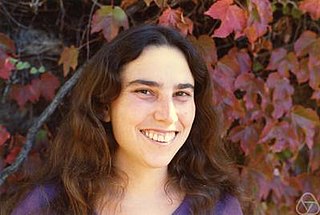Related Research Articles

Dusa McDuff FRS CorrFRSE is an English mathematician who works on symplectic geometry. She was the first recipient of the Ruth Lyttle Satter Prize in Mathematics, was a Noether Lecturer, and is a Fellow of the Royal Society. She is currently the Helen Lyttle Kimmel '42 Professor of Mathematics at Barnard College.

In mathematics, the unknotting problem is the problem of algorithmically recognizing the unknot, given some representation of a knot, e.g., a knot diagram. There are several types of unknotting algorithms. A major unresolved challenge is to determine if the problem admits a polynomial time algorithm; that is, whether the problem lies in the complexity class P.

Chuu-Lian Terng is a Taiwanese-American mathematician. Her research areas are differential geometry and integrable systems, with particular interests in completely integrable Hamiltonian partial differential equations and their relations to differential geometry, the geometry and topology of submanifolds in symmetric spaces, and the geometry of isometric actions.

Sun-Yung Alice Chang is a Taiwanese American mathematician specializing in aspects of mathematical analysis ranging from harmonic analysis and partial differential equations to differential geometry. She is the Eugene Higgins Professor of Mathematics at Princeton University.

Carolyn S. Gordon is a mathematician and Benjamin Cheney Professor of Mathematics at Dartmouth College. She is most well known for giving a negative answer to the question "Can you hear the shape of a drum?" in her work with David Webb and Scott A. Wolpert. She is a Chauvenet Prize winner and a 2010 Noether Lecturer.
The Ruth Lyttle Satter Prize in Mathematics, also called the Satter Prize, is one of twenty-one prizes given out by the American Mathematical Society (AMS). It is presented biennially in recognition of an outstanding contribution to mathematics research by a woman in the previous six years. The award was funded in 1990 using a donation from Joan Birman, in memory of her sister, Ruth Lyttle Satter, who worked primarily in biological sciences, and was a proponent for equal opportunities for women in science. First awarded in 1991, the award is intended to "honor [Satter's] commitment to research and to encourage women in science". The winner is selected by the council of the AMS, based on the recommendation of a selection committee. The prize is awarded at the Joint Mathematics Meetings during odd numbered years, and has always carried a modest cash reward. Since 2003, the prize has been $5,000, while from 1997 to 2001, the prize came with $1,200, and prior to that with $4,000. If a joint award is made, the prize money is split between the recipients.
There is a long history of women in mathematics in the United States. All women mentioned here are American unless otherwise noted.
This is a timeline of women in mathematics.

Ruth Michele Charney is an American mathematician known for her work in geometric group theory and Artin groups. Other areas of research include K-theory and algebraic topology. She holds the Theodore and Evelyn G. Berenson Chair in Mathematics at Brandeis University. She was in the first group of mathematicians named Fellows of the American Mathematical Society. She was in the first group of mathematicians named Fellows of the Association for Women in Mathematics. She served as president of the Association for Women in Mathematics during 2013–2015, and served as president of the American Mathematical Society for the 2021–2023 term.
Laura Grace DeMarco is a professor of mathematics at Harvard University, whose research concerns dynamical systems and complex analysis.
Julia Elisenda (Eli) Grigsby is an American mathematician who works as a professor at Boston College. Her research began with the study of low-dimensional topology, including knot theory and category-theoretic knot invariants. She is currently working in the field of machine learning.

Emily Riehl is an American mathematician who has contributed to higher category theory and homotopy theory. Much of her work, including her PhD thesis, concerns model structures and more recently the foundations of infinity-categories. She is the author of two textbooks and serves on the editorial boards of three journals.
Vladimir Georgievich Turaev is a Russian mathematician, specializing in topology.

Jennifer Shyamala Sayaka Balakrishnan is an American mathematician known for leading a team that solved the problem of the "cursed curve", a Diophantine equation that was known for being "famously difficult". More generally, Balakrishnan specializes in algorithmic number theory and arithmetic geometry. She is the Clare Boothe Luce Associate Professor at Boston University.
Efstratia (Effie) Kalfagianni is a Greek American mathematician specializing in low-dimensional topology.
The Joan & Joseph Birman Research Prize in Topology and Geometry is a prize given every other year by the Association for Women in Mathematics to an outstanding young female researcher in topology or geometry. The prize fund for the award was endowed by a donation in 2013 from Joan Birman and her husband, Joseph Birman, and first awarded in 2015.
Tara Elise Brendle is an American mathematician who works in geometric group theory, which involves the intersection of algebra and low-dimensional topology. In particular, she studies mapping class group of surfaces, including braid groups, and their relationship to automorphism groups of free groups and arithmetic groups. She is a professor of mathematics and head of mathematics at the University of Glasgow.
Karen Melnick is a mathematician and associate professor at University of Maryland, College Park. She specializes in differential geometry and was most recently awarded the 2020-2021 Joan and Joseph Birman Fellowship for Women Scholars by the American Mathematical Society.

Bianca L. Viray is an American mathematician and professor at the University of Washington in Seattle. She works in arithmetic geometry, which is a blend of algebraic geometry and algebraic number theory.

Braids, Links, and Mapping Class Groups is a mathematical monograph on braid groups and their applications in low-dimensional topology. It was written by Joan Birman, based on lecture notes by James W. Cannon, and published in 1974 by the Princeton University Press and University of Tokyo Press, as volume 82 of the book series Annals of Mathematics Studies.
References
- 1 2 Larry Riddle. "Joan S. Birman", Biographies of Women Mathematicians, at Agnes Scott College
- ↑ "Home Page for Joan S. Birman". www.math.columbia.edu. Retrieved 2020-11-06.
- 1 2 "Birman biography". www-history.mcs.st-andrews.ac.uk. Retrieved 2017-09-23.
- ↑ "Joseph L. Birman (1927–2016)". www.aps.org. Retrieved 2018-04-02.
- 1 2 Joan Sylvia Lyttle Birman at the Mathematics Genealogy Project
- ↑ "Autobiography by Joan S. Birman". Celbratio Mathematica. Mathematical Sciences Research Institute. Retrieved 20 February 2021.
- ↑ "Working at Their Full Potential: The Impact of the AMS Birman Fellowship" (PDF). American Mathematical Society. March 7, 2022. Retrieved October 20, 2022.
- 1 2 Margalit, Dan (2019). "The Mathematics of Joan Birman" (PDF). AMS Notices. 66 (3).
- ↑ Institute for Advanced Study: A Community of Scholars
- 1 2 3 Jackson, Allyn; Traynor, Lisa (January 2007). "Interview with Joan Birman" (PDF). Notices of the American Mathematical Society. 54 (1): 20–29. Retrieved 20 February 2021.
- ↑ Lam, Wai-TIng (Jul–Aug 2009). "The Charm of Topology Dr. Joan Birman: Mathematics is very beautiful". Newsletter of the Association for Women in Mathematics. 39 (4): 6–7.
- ↑ "American Mathematical Society – The Joan and Joseph Birman Fellowship for Women Scholars". www.ams.org. Retrieved 2018-04-02.
- ↑ "AMS Committees". American Mathematical Society. Retrieved 2023-03-27.
- ↑ "Alfred P. Sloan Foundation Past Fellows". Alfred P. Sloan Foundation. Archived from the original on 14 March 2018. Retrieved 20 February 2021.
- ↑ "Noether Lectures 1987 Lecturer: Joan S. Birman". Association for Women in Mathematics. Retrieved 10 April 2021.
- ↑ "Joan S. Birman". John Simon Guggenheim Foundation. Retrieved 2021-02-20.
- ↑ Birman, Joan (1993). "New Points of View in Knot Theory". Bull. Amer. Math. Soc. (N.S.). 28 (2): 253–287. arXiv: math/9304209 . Bibcode:1993math......4209B. doi:10.1090/s0273-0979-1993-00389-6. S2CID 17229952.
- ↑ "Joan S. Birman". European Academy of Sciences. Retrieved 2021-02-20.
- ↑ "Prof. Joan S. Birman '48 elected to the American Academy of Arts and Sciences". Barnard College. 2012-04-17. Retrieved 2021-02-20.
- ↑ "Joan S. Lyttle Birman". American Academy of Arts & Sciences. 2021-02-09. Retrieved 2021-02-20.
- ↑ List of Fellows of the American Mathematical Society, retrieved 2012-11-10.
- ↑ "AWM Birman Research Prize". Association for Women in Mathematics (AWM). Retrieved 2022-12-01.
- ↑ "Honorary Members 2015". Bulletin of the London Mathematical Society. 48 (3): 548–556. 2016-03-28. doi:10.1112/blms/bdw014. ISSN 0024-6093. S2CID 247694394.
- ↑ 2020 Class of AWM Fellows, Association for Women in Mathematics , retrieved 2019-11-08
- ↑ "2021 NAS Election". National Academy of Sciences. Retrieved 26 April 2021.
- ↑ "Mathematicians of EvenQuads Deck 1". awm-math.org. Retrieved 2022-06-18.
- ↑ Magnus, W. (1976). "Review: Braids, links and mapping class groups by Joan S. Birman" (PDF). Bull. Amer. Math. Soc. 82: 42–45. doi: 10.1090/s0002-9904-1976-13937-7 .